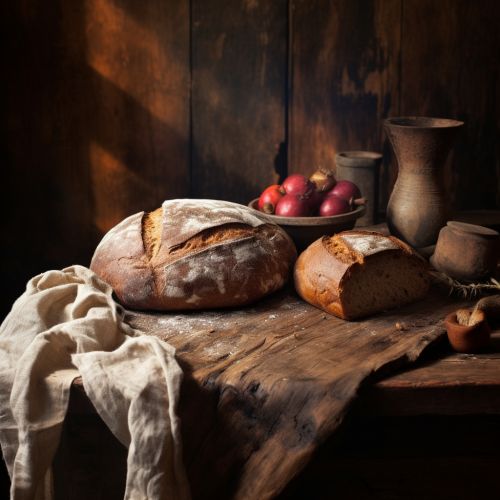Bread
History
Bread, one of the oldest prepared foods, has a significant history that dates back to the Neolithic era. The first bread produced was probably cooked versions of a grain-paste, made from ground grain and water, and may have been developed by accidental cooking or deliberate experimentation with water and grain flour. Descendants of this early bread are still commonly made from various grains worldwide, including the Mexican tortilla, Indian roti, and Ethiopian injera. The Neolithic Revolution, which occurred around 10,000 BC, ushered in agriculture, which significantly increased the availability of food grains and led to a major increase in the production of bread.


Ingredients and Process
The basic ingredients of bread are flour and water. Other ingredients such as salt, fat, sugar, yeast, and various grains and seeds can be included. The process of making bread can involve up to 20 different steps. These include: obtaining the ingredients, mixing, fermenting, punching down, portioning, rounding, benching, shaping, final proofing, baking, cooling, and packaging. Each step is crucial to the final product, and the omission of any step can result in a subpar loaf of bread.
Types of Bread
There are many different types of bread, each with its own unique characteristics. Some of the most common types include:
- White bread: This is the most common type of bread in many Western countries. It is made from wheat flour from which the bran and the germ have been removed through a process known as milling.
- Whole wheat bread: This type of bread is made from whole grain wheat and contains more fiber than white bread.
- Rye bread: Made from rye grain, this bread has a stronger flavor than bread made from wheat flour.
- Sourdough: This bread has a slightly sour taste due to the fermentation process it undergoes.
- Baguette: This is a long, thin loaf of bread that originated in France.
Nutritional Value
Bread is a staple food in many cultures and provides a significant portion of people’s daily intake of nutrients. It is a source of carbohydrates, protein, fiber, vitamins, and minerals. However, not all breads are created equal. Whole grain bread, for example, is more nutritious than white bread as it contains all parts of the grain — the bran, germ, and endosperm.
Cultural Significance
Bread has a significant cultural and symbolic significance in many societies. It is often used in religious rituals, ceremonies, and celebrations. In Christianity, for example, bread is used in the sacrament of the Eucharist. In many cultures, bread is a metaphor for basic necessities and living conditions in general.
